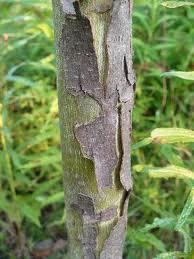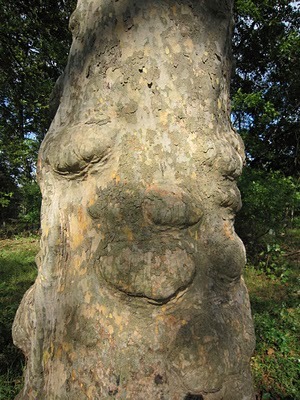QuestionQUESTION: The city I live in has many old sections where the Sycamore was a popular tree both in the city and the outskirts. The trees are very large and very mature. On many of them there are large, smooth bulges that droop down on the main trunk. It almost looks as though the trunk were melting. Do you know what causes this? I can find no pictures on the web which I find odd.
 Sycamore bark
Sycamore bark
ANSWER: I think you are referring to the bark of the sycamore tree. An American sycamore tree is easily recognized by its mottled exfoliating bark. The bark of the trunk and larger limbs flakes off in great irregular masses, leaving the surface mottled, and greenish-white, gray and brown. Sometimes the smaller limbs look as if whitewashed. The explanation is found in the rigid texture of the bark tissue, which lacks the elasticity common to the bark of other trees, so it is incapable of stretching to accommodate the growth of the wood underneath and the tree sloughs it off.
This sounds normal.
See picture
---------- FOLLOW-UP ----------
 Sycamore
Sycamore
QUESTION: I'm sorry, I think you misunderstood what I was asking. I am familiar with the bark & sloughing of it as I have a midsized one in my front yard. My question pertains to the smooth but drooping bulges in the trunks of some really old Sycamores. Are they caused by cankers?
AnswerThanks for the picture that helped clear the question up.
These are called burls. Burls are abnormal growths on the trunks and branches of trees. The tumor-like growths are caused by a number of factors, some of which are unknown. Some disease organisms, such as the Phomopsis fungus, cause a swelling of woody tissues, rather than a sunken canker typical of Nectria and other common tree diseases. A grown-over branch collar on the trunk of a tree will leave a bump, but that抯 not really a burl. A true burl is not caused by a pathogen (as far as we know). The uncontrolled growth of tissue in a burl leaves a hemispherical bump on the tree without typical growth rings and wood structure.
Apparently, little research has been done into the causes of burls. Computer search engines yield all sorts of information for woodworkers, and sources for buying burled wood, but next to nothing about the biology of burls on trees. Burls may serve as infection courts for diseases, but as a rule they do not appear to be harmful to the trees. They certainly should not be removed, since that would expose a large wound that would surely allow decay or diseases into the tree.
The burls are looked at by wood worker as prizes that can be made into beautiful wood art. Do not worry about the burls they pose no health threat to the trees. Enjoy them!!







